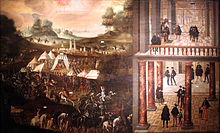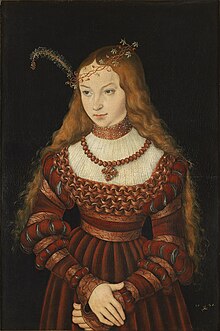John Frederick I, Elector of Saxony
| John Frederick I | |
|---|---|
 Portrait by Lucas Cranach the Elder, 1531. | |
| Elector of Saxony | |
| Reign | 16 August 1532 – 24 April 1547 |
| Predecessor | John |
| Successor | Maurice |
| Duke of Saxony | |
| Reign | 24 April 1547 – 3 March 1554 |
| Predecessor | Maurice |
| Successor | John Frederick II |
| Landgrave of Thuringia | |
| Reign | 16 August 1532 – 24 April 1547 |
| Predecessor | John |
| Successor | John Ernest |
| Born | 30 June 1503 Torgau, Electorate of Saxony, Holy Roman Empire |
| Died | 3 March 1554 (aged 50) Weimar, Electorate of Saxony, Holy Roman Empire |
| Burial | |
| Spouse | Sybille of Cleves |
| Issue | John Frederick II, Duke of Saxony John William, Duke of Saxe-Weimar John Frederick III, Duke of Saxe-Gotha |
| House | House of Wettin Ernestine Line |
| Father | John, Elector of Saxony |
| Mother | Sophie of Mecklenburg-Schwerin |
| Religion | Lutheranism |
John Frederick I (German: Johann Friedrich I; 30 June 1503, in Torgau – 3 March 1554, in Weimar), called John the Magnanimous, or St. John the Steadfast (by Lutherans), was Elector of Saxony and Head of the Protestant Confederation of Germany (the Schmalkaldic League), "Champion of the Reformation".
Early years

John Frederick was the eldest son of Elector John by his first wife, Sophie of Mecklenburg-Schwerin. His mother died fourteen days after his birth, on 12 July 1503.
He received his education from George Spalatin, whom he highly esteemed during his whole life. Spalatin was Martin Luther's friend and advisor and thus, through Spalatin's schooling, John developed a devotion to the teachings of Martin Luther. His knowledge of history was comprehensive, and his library, which extended over all sciences, was one of the largest in Germany.
He cultivated a personal relationship with Martin Luther, beginning to correspond with him in the days when the bull of excommunication was hurled against the Reformer, and showing himself a convinced adherent of Luther. With vivid interest he observed the development of the reformatory movement. He eagerly read Luther's writings, urged the printing of the first complete (Wittenberg) edition of his works, and in the latter years of his life promoted the compilation of the Jena edition. At the Elector castle at Torgau, he constructed a chapel specifically designed to be a Lutheran place of worship and invited Martin Luther to deliver the inaugural sermon. The influence of Lutheranism at John Frederick's court is visible also in the translation by Veit Warbeck of the French romance the Magelone, made in preparation of John Frederick's marriage in 1527; Catholic elements are suppressed.[1]
His father introduced him into the political and diplomatic affairs of the time, and he conducted the first negotiations of a treaty with Hesse in Kreuzburg and Friedewald. He took an active part in the disturbances caused by the Pack affair (see John the Steadfast), and Luther was grateful to him for his exertions, in spite of his youth, for the maintenance of peace.
During the second diet of Speyer (1529) he temporarily assumed the reins of government in place of his father. The intrigues of Archduke Ferdinand induced him after the diet to draw up a federal statute for the Evangelical estates, which shows that he was more decidedly convinced of the right and duty of defense than his father. He accompanied the latter to the Diet of Augsburg in 1530, signed with him the Augsburg Confession and was active in the proceedings. His attitude did not remain unnoticed, and won him the emperor's dislike.
Elector of Saxony
In 1532, John Frederick succeeded his father as elector. In the beginning he reigned with his half-brother, John Ernest, but in 1542 became sole ruler.
Chancellor Brück, who for years had guided the foreign relations of the country with ability and prudence, remained also his councilor, but his open and impulsive nature often led him to disregard the propositions of his more experienced adviser, so that the country was in frequent danger, especially as John Frederick was not a far-sighted politician.

He consolidated the Lutheran State Church by the institution of an electoral consistory (1542) and renewed the church visitation. He took a firmer and more decided stand than his father in favor of the Schmalkaldic League, but on account of his strictly Lutheran convictions was involved in difficulties with the Landgrave of Hesse, who favored a union with the Swiss and Strasburg Evangelicals. He was averse to all propositions of Popes Clement VII and Paul III to support calling a General Council, because he was convinced that it would only serve "for the preservation of the papal and anti-Christian rule"; but to be prepared for any event, he requested Luther to summarize all articles to which he would adhere before a council, and Luther wrote the Schmalkald Articles. At the Diet of Schmalkalden in 1537 the council was refused, and the elector treated the papal legate with open disregard and rejected the propositions of Dr. Held, the imperial legate.
He followed the efforts at agreement at the conference of Regensburg in 1541 with suspicion and refused to accept the article on justification which had been drawn up under the supervision of Gasparo Contarini to suit both parties, and Luther, his steady adviser, confirmed him in his aversion. The efforts at agreement failed, and the elector contributed not a little to broaden the gulf by his interference in the ecclesiastical affairs of Halle and by aiding the Reformation which had been introduced there by Justus Jonas. His attitude became more and more stubborn and regardless of consequences, not to the advantage of the Protestant cause.
In spite of the warnings of the emperor, of Brück, and of Luther, he arbitrarily set aside in 1541 the election of Julius von Pflug as the BIshop of Naumburg, and instead instituted Nicolaus von Amsdorf as bishop, and introduced the Reformation. In 1542 he expelled Duke Henry of Brunswick-Wolfenbüttel from his country to protect the Evangelical cities Goslar and Brunswick and introduced the Reformation there. New war-like entanglements hindered Charles V from interfering and by apparently yielding he succeeded in concealing his true intentions. The elector appeared personally at the diet of Speyer in 1544. The harmony of the emperor with the Evangelicals appeared never greater than at that time. He permitted the Regensburg declaration of 1541 to be embodied in the new recess and acknowledged all innovations which the Evangelicals had made between 1532 and 1541 because he needed the aid of the Protestants against France. John Frederick actually thought that peace had come and continued the ecclesiastical reforms in his country. Even the growing discord among the allies did not disturb him.

When the Schmalkaldic War broke out in 1546, he marched to the south at the head of his troops, but the unexpected invasion of his country by his cousin Duke Maurice compelled him to return. He succeeded in reconquering the larger part of his possessions and repelling Maurice, but suddenly the emperor hastened north and surprised the elector. The Battle of Mühlberg, 24 April 1547, went against him and dispersed his army. He received a slashing wound to the left side of his face, leaving him with a disfiguring scar from his lower eye socket down his cheek. He was taken prisoner by Charles V and sent into exile in Worms.
Prisoner

Emperor Charles V condemned him to death as a convicted rebel; but, not to lose time in the siege of Wittenberg, which was defended by Sybille, the wife of the elector, he did not execute the sentence and entered into negotiations. To protect and save his wife and sons, and to prevent Wittenberg from being destroyed, John Frederick conceded the Capitulation of Wittenberg, and, after having been compelled to resign the government of his country in favor of Maurice of Saxony, his condemnation was changed into imprisonment for life.
He was never greater and more magnanimous than in the days of his captivity,[citation needed] as is evident from the correspondence with his children, his wife, and his councilors. Friends and foes were compelled to acknowledge his calm behavior, his unwavering faith, and his greatness under misfortune. He steadfastly refused to renounce the Protestant faith or to acknowledge the Augsburg Interim, declaring that by its acceptance he would commit "a sin against the Holy Ghost, because in many articles it was against the Word of God". Though offered several opportunities to be set free, if he would but compromise his faith and convictions, he steadfastly refused, and urged his sons to remain strong and faithful.
Final days

The sudden attack upon the emperor by Elector Maurice made an end of John Frederick's imprisonment, and he was released on 1 September 1552. He firmly refused to bind himself to comply in matters of religion with the decisions of a future council or diet, declaring that he was resolved to adhere until his grave to the doctrine contained in the Augsburg Confession. His homeward journey was a triumphal march. He removed the seat of government to Weimar and reformed the conditions of his country, but died within two years. A special object of his care was the University of Jena, which he planned in place of Wittenberg, which he had lost (1547). He died in Weimar, Germany.
Ancestry
Marriage and family

In Torgau on 9 February 1527 John Frederick married Sibylle of Cleves. They had four sons:
- Johann Frederick II, Duke of Saxony (b. Torgau, 8 January 1529 – d. as imperial prisoner at Schloss Steyer, Upper Austria, 19 May 1595)
- Johann Wilhelm, Duke of Saxe-Weimar (b. Torgau, 11 March 1530 – d. Weimar, 2 March 1573)
- Johann Ernst (b. Weimar, 5 January 1535 – d. Weimar, 11 January 1535)
- Johann Frederick III, Duke of Saxe-Gotha (1554–1565) (b. Torgau, 16 January 1538 – d. Jena, 31 October 1565).
-
Johann Frederick III at right.
References
- ^ Krömmelbein, Thomas (1987). "Veit Warbeck und die kurzweilige Historia von der schönen Magelone by Gmünder Volkshochschule". Zeitschrift für deutsches Altertum und deutsche Literatur. 116 (2): 67–69.
 This article incorporates text from a publication in the public domain: Jackson, Samuel Macauley, ed. (1914). New Schaff–Herzog Encyclopedia of Religious Knowledge (third ed.). London and New York: Funk and Wagnalls.
This article incorporates text from a publication in the public domain: Jackson, Samuel Macauley, ed. (1914). New Schaff–Herzog Encyclopedia of Religious Knowledge (third ed.). London and New York: Funk and Wagnalls. {{cite encyclopedia}}: Missing or empty|title=(help) [1]- A. Beck, Johann Friedrich der Mittlere, 2 vols., Weimar, 1858
- F. von Bezold, Geschichte der deutschen Reformation. Berlin, 1886
- Biography on WHKLMA site
Translations
- A Prince's Response to the Augsburg Interim, translated by Nathaniel J. Biebert (Red Brick Parsonage, 2015).
External links



